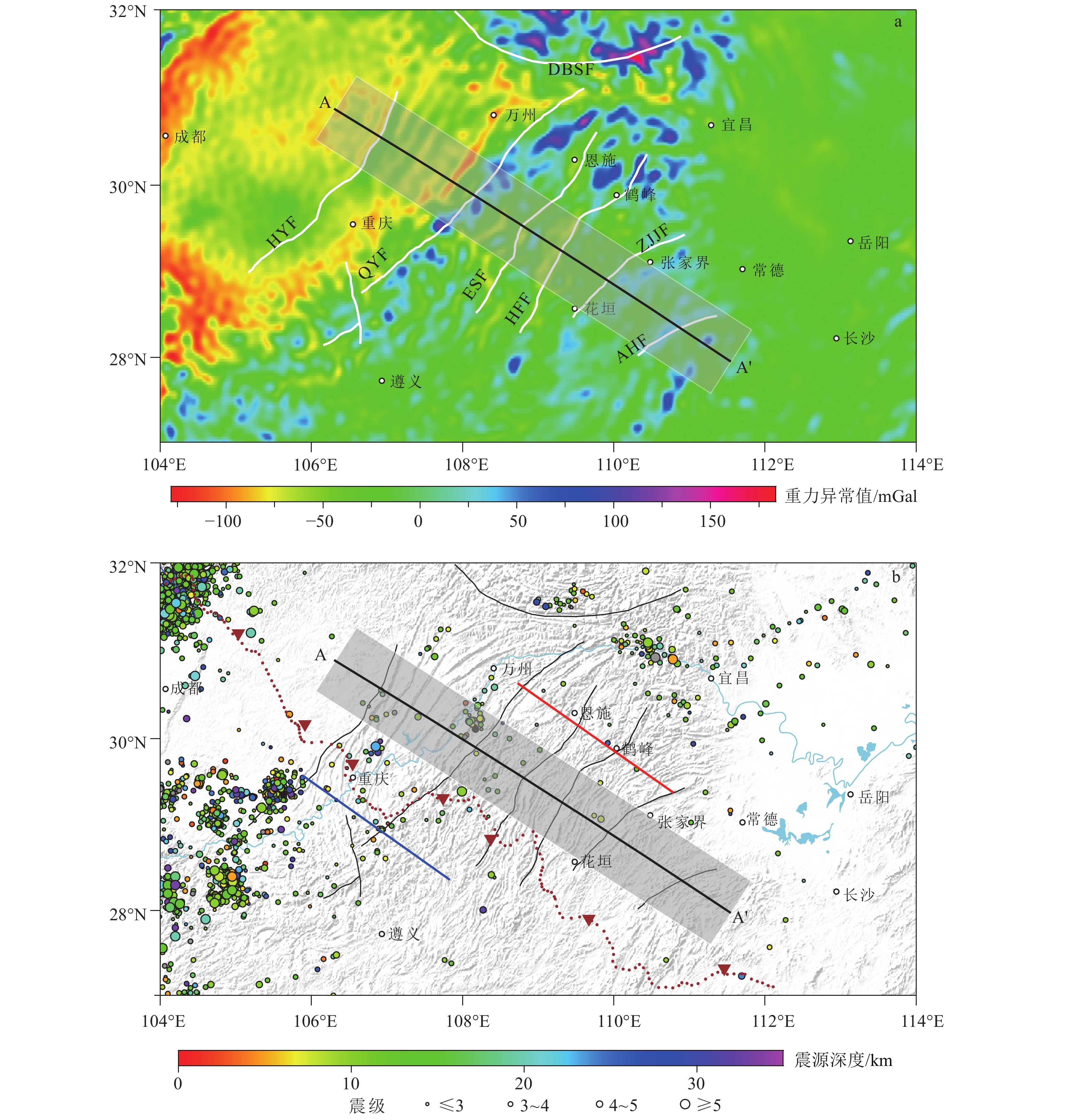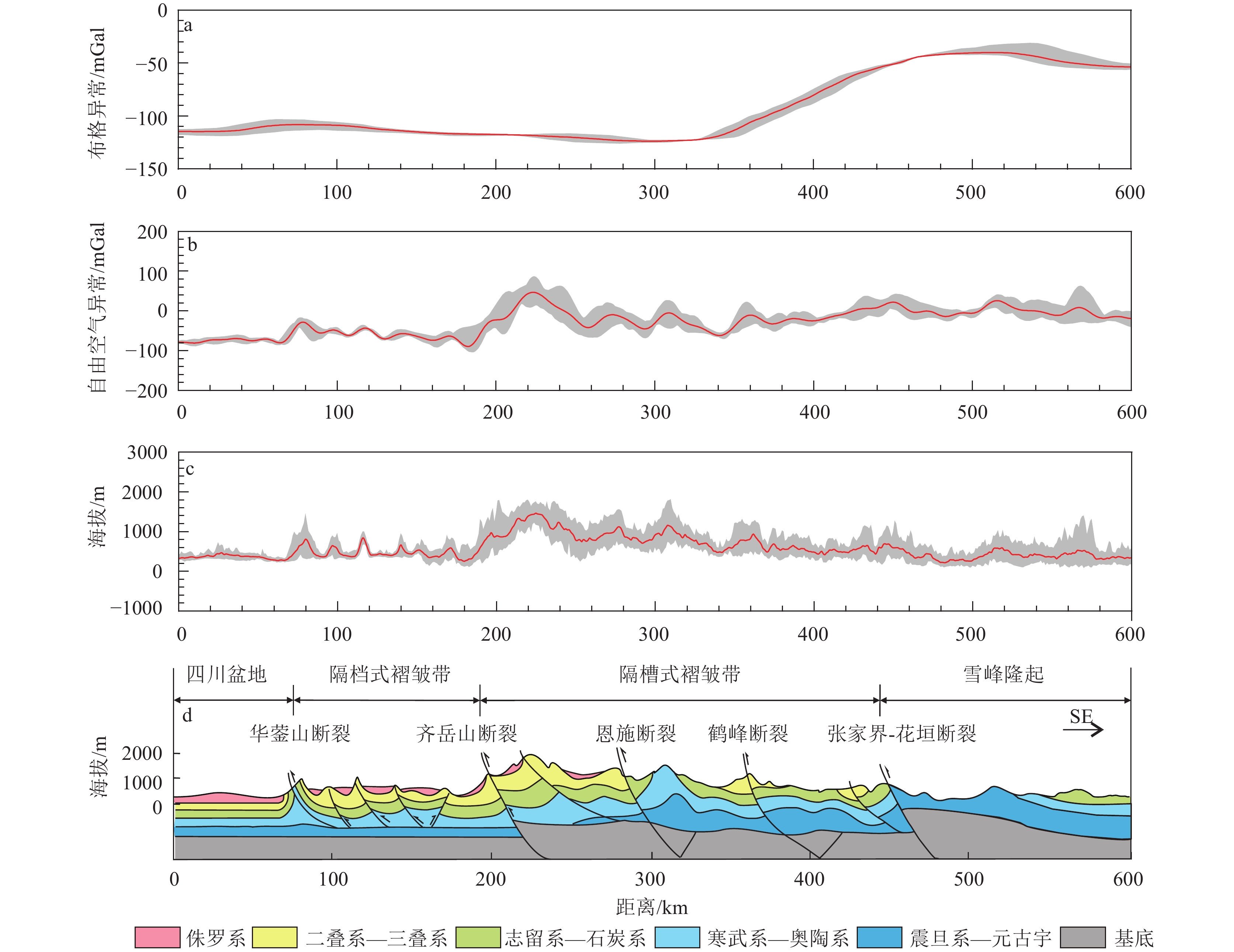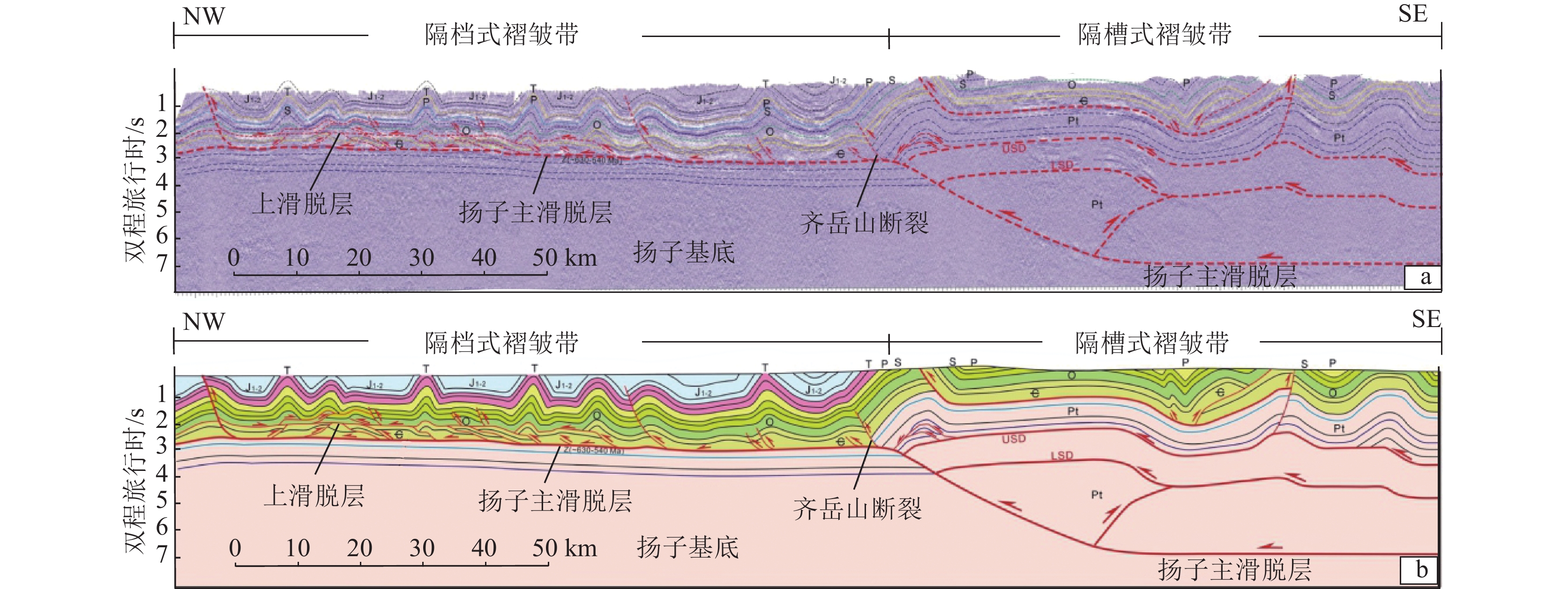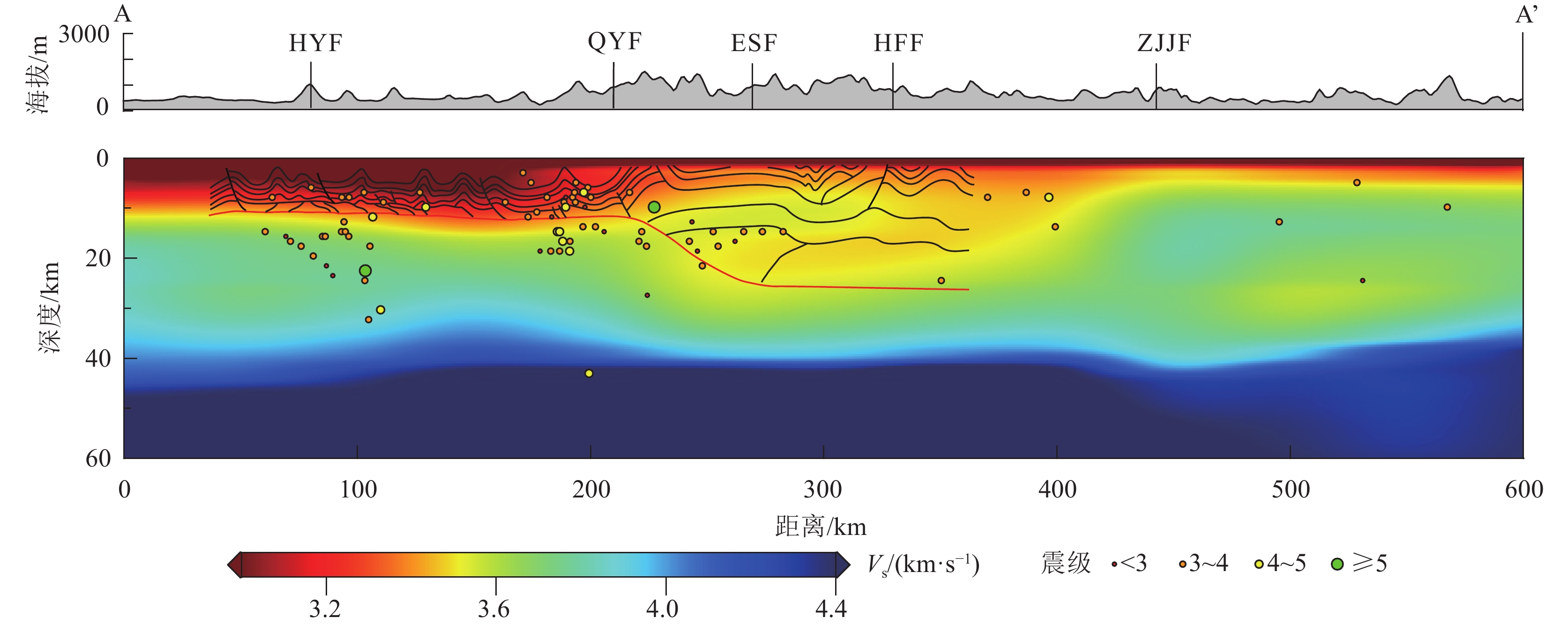Crustal structure and formation mechanism of the fold-and-thrust belt in and around Wuling mountains region
-
摘要:
武陵山褶皱−冲断构造带位于扬子块体东缘,是华南地区最典型的由陆内挤压作用形成的重要线性构造带,了解其地壳结构与变形机制对于进一步深化认识该地区的构造演化过程至关重要。本文在综合多种地球物理成像、构造地质分析和数值、物理模拟研究的基础上,系统分析了该区的地壳深部结构、变形过程及浅表构造响应。结果表明:武陵山地区强重力梯度带的形成主要受控于地壳与岩石圈尺度的结构和物性差异;新元古代扬子和华夏块体的拼合过程造成了目前的地壳结构,形成莫霍界面的起伏、错断、叠置等变形特征;低速滑脱层和先存的区域断裂一起造成了上、下地壳的变形解耦,并在该区的构造演化中发挥了关键控制作用;晚中生代古太平洋板块俯冲产生的远场应力可能是造成该区褶皱−冲断变形的主要动力。本研究可为华南地区陆内变形机制研究提供新的启示,并有助于为其他地区开展类似研究提供借鉴。
Abstract:The Wuling fold−and−thrust belt, located along the eastern margin of the Yangtze block, is a significant linear tectonic belt shaped by the intra−continental compressional forces in South China. Understanding its formation mechanisms is crucial for advancing broader tectonic evolution of the region. This study examines the deep crustal architecture, deformation processes, and surface tectonics within the Wuling fold−and−thrust belt by integrating high−resolution geophysical imaging, detailed tectonic analysis, and recent numerical and analog modeling. The key findings are as follows: ① The pronounced gravity gradient belt across the Wuling Mountains is primarily controlled by structural and compositional variations at the crustal and lithospheric levels; ② The Neoproterozoic collision and subsequent amalgamation of the Yangtze and Cathaysia blocks shaped the crustal structure, leading to the Moho undulation, break−off, imbrication, and other related features; ③ A low−velocity décollement layer, in combination with pre−existing regional faults, facilitated crustal decoupling and played a critical role in the structural evolution of the belt; ④ Far−field stresses from Paleo−Pacific plate subduction during the Late Mesozoic were the primary drivers of the observed fold−and−thrust deformation. These findings may offer new insights into knowledge on the intra−continental deformation mechanisms in South China and also contribute to refining tectonic models in other similar regions.
-
传统的板块构造理论(Dewey et al., 1970)认为,造山带是在板块边缘发生的强烈挤压变形作用,这意味着造山作用或大陆变形通常发生于板块边界附近(Raimondo et al., 2014)。然而,在远离板块边缘的大陆内部也可能存在显著的挤压变形,即陆内变形(Raimondo et al., 2014; Li et al., 2022)。与发生在板块边缘的造山或变形特征不同,陆内变形没有直接的板块和板缘相互作用的物质表现,缺乏大洋板片俯冲、蛇绿岩套及弧岩浆作用的证据,但它是地壳增厚、缩短和叠置作用发生的典型场所,有时还会伴随大规模的滑脱作用并在地表以褶皱−冲断带的形式广泛表现(Poblet et al., 2011),在沉积建造、岩浆活动、变质作用及成矿过程方面,具有独特的特征(崔盛芹,1999)。
华南块体由北西侧扬子块体和南东侧华夏块体于新元古代碰撞拼贴形成,古生代以后以陆内造山和变形为主,经历了多期次、幕式的地壳生长和变形过程。尤其是中生代以来,受古特提斯和古太平洋2个巨型构造域交汇影响,华南地区经历了强烈的变形和岩浆活动并形成特有的构造格局。在华南块体东部,古太平洋板块俯冲及其角度变化和回撤作用导致了岩石圈尺度的强烈伸展,岩石圈和地壳明显变薄,伴随有丰富的岩浆和成矿作用(Zhou et al., 2006; Hu et al., 2008; Li et al., 2017; Lü et al., 2021; Zhang et al., 2021a, b)。相比之下,华南块体中西部则几乎未受到古太平洋板块俯冲作用的直接影响,其构造变形以陆内造山或挤压为主,岩浆活动弱、地壳缩短量大、岩石圈较厚、线性褶皱−冲断带构造广泛发育,属于典型的陆内构造系统(图1),为研究陆内褶皱−冲断带的形成机制与地壳尺度的深部构造变形特征和控制因素提供了良好场所(Hsü et al., 1988; Yan et al., 2003; Wang et al., 2005; Chu et al., 2012; Dong et al., 2015; Li et al., 2018)。
近年来,针对华南块体中西部地区的褶皱−冲断构造,许多学者在地质构造、年代学方面开展了大量研究,在浅表构造的样式、性质、变形时间等方面取得了显著进展,很大程度上提高了对该地区地表及浅层构造的理解(Yan et al., 2003, 2009; Wang et al., 2005; Chu et al., 2012)。然而,对该区陆内褶皱−冲断带的形成机制、应力传播机制、深部控制因素等目前仍然存在争议(Coblentz et al., 1995; Hillis et al., 2008; Johnston., 2008),主要包括不同类型褶皱−冲断体系的形成过程、陆内变形的深部结构特征、浅部变形与深部变形是否耦合等问题。Yan et al. (2003)认为,川东—武陵山地区的变形属于印支期扬子块体陆内造山事件的一部分,是华北和华南块体碰撞挤压造成的结果;而Chu et al. (2012)将雪峰山构造带解释为受控于SE方向的古太平洋板块俯冲作用的远程影响;也有学者认为该区发育的不同类型褶皱是由地表剥蚀程度的差异造成的(刘尚忠,1995)。这些争论存在的原因一方面是由于该区构造本身的复杂性,另一方面也因为缺乏对该区深部结构及深浅构造耦合方面的研究。
针对上述问题,本研究以华南中西部的川东−武陵山−雪峰山陆内褶皱−冲断带为研究对象,系统收集并分析了近年来在该区开展的构造地质、年代学、地球物理探测和物理与数值模拟研究成果,以跨越该区线性褶皱−冲断带的一条NW—SE向构造廊带为切入点,聚焦于该区地壳深部结构特征及其浅表构造响应,并尝试分析其变形产生的深部机制与动力学过程。
1. 区域构造背景和地球物理场特征
川东—武陵山地区西起四川盆地东至江南−雪峰造山带,包括华蓥山断裂、齐岳山断裂、张家界断裂等主要断裂带,江南−雪峰造山带是新元古代由扬子和华夏块体碰撞拼贴而形成(Charvet et al., 1996; Cawood et al., 2013)。古生代以来,该区远离俯冲板块边缘,在构造体制上成为陆内造山与变形区域。早古生代晚期、晚古生代晚期及早中生代该地区表现为整体的抬升作用,对应构造活动的地层接触关系均为平行不整合,不发育褶皱构造(Shu et al., 2015; 李三忠等, 2016;舒良树, 2019)。晚侏罗世—早白垩世,区内发生大规模褶皱−逆冲作用,造成区域内地层出现角度不整合,川东褶皱带内发育多套滑脱层,并随着挤压作用的持续逐渐演变为一个大型走滑断裂系统(刘重庆等,2013;张小琼等,2013;He et al., 2018; 王宗秀等, 2019)。在晚白垩世经历短期的伸展作用之后,受印度与欧亚大陆汇聚作用的影响,该区以挤压隆升变形为主,早期形成的褶皱构造受到强烈改造(Wang et al., 2014; 王宗秀等,2019)。
该区构造变形的主要特征是以齐岳山断裂为界的东部隔槽式褶皱和西部隔挡式褶皱组成的“侏罗山式”褶皱带(颜丹平等, 2000; Yan et al., 2003; 胡召齐等, 2009; Wang et al., 2010)。构造变形及年代学研究表明,研究区晚侏罗世—早白垩世整体为自SE向NW的递进逆冲作用,目前观测到的构造痕迹主要反映了中生代的构造演化过程(颜丹平等, 2000;Yan et al., 2003; 胡召齐等, 2009;梅廉夫等,2010;汪新伟等,2010;Li et al., 2014;Dong et al., 2015;颜丹平等, 2018)。其中,隔挡式褶皱的特点是向斜轴部宽大、背斜轴部很窄,主要表现为箱状褶皱;一般向斜中心为侏罗系,而背斜核部大多出露下—中三叠统,仅华蓥山中段背斜核部出露下古生界;而隔槽式褶皱基底卷入地层主要为海相盖层,呈现背斜宽大、向斜狭窄的特征,同样以箱状褶皱为主。背斜核部多出露南华系-奥陶系,而向斜核部主要为中-下三叠统,在地表常表现为极宽缓的背斜(颜丹平等, 2000; Yan et al., 2003;冯向阳等, 2003; Wang et al., 2005;张必龙等,2009)。
该区构造线方向主体由NNE向转向NE向,自东向西主要包括张家界断裂(ZJJF)、鹤峰断裂(HFF)、恩施断裂(ESF)、齐岳山断裂(QYF)、华蓥山断裂(HYF)。其中,张家界断裂在地形上是武陵山的东界,也是传统认为的江南造山带的西界;齐岳山断裂控制着两侧的褶皱样式和地形高程,是川东隔挡式褶皱和武陵山隔槽式褶皱的分界断裂(张小琼等,2013);华蓥山断裂是四川盆地东部的一条主干断裂,在其东部为广泛发育的线性褶皱构造变形带,在其西部则为平缓展布的侏罗系。此外,该区域还发育很多次级断裂,例如鹤峰断裂、恩施断裂等。
基于EIGEN6C4重力场模型提取的川东—武陵山地区的自由空气异常,显示了该区重力场的横向变化特征(图2–a)。研究区自由空气异常的分布特征总体与构造单元分布较一致。在东部江汉盆地地域为近零值或负值;在中部武陵山地区表现出高低值相间的分布特征;在四川盆地主要为明显的负值,尤其是在四川盆地西北和南部边缘地区,负值特征更明显;在北部大巴山地区则主要为正值分布。由于自由空气异常未经过地形改正和中间层改正,因此其低频部分信号大体反映了深部介质的密度变化情况,而高频部分信号保留了因地形起伏及其伴随的密度亏损等因素所造成的局部重力异常特征。通过对比图2–a和图2–b可见,自由空气重力异常在川东和武陵山地区呈现出明显的地形相关性,即在地形隆起区为较高的自由空气异常值,在地形较低而平缓的地区为近零值或负异常值。
![]() 图 2 研究区自由空气重力异常(a)和地形起伏与主要探测剖面位置(b)(断裂代号同图1)(图a中断裂名称缩写同图1;图b中黑色实线及阴影部分为本次选取的A-A′构造廊带;蓝色实线为Li et al. (2018)文中反射剖面的位置;红色实线为Huang et al. (2014)文中测线AA′的台站位置;红棕色圆点及倒三角为李英康等(2019)文中接收点和炮点位置)Figure 2. Free-air gravity anomaly (a) and locations of geophysical profiles on the topographic map (b) of the study area
图 2 研究区自由空气重力异常(a)和地形起伏与主要探测剖面位置(b)(断裂代号同图1)(图a中断裂名称缩写同图1;图b中黑色实线及阴影部分为本次选取的A-A′构造廊带;蓝色实线为Li et al. (2018)文中反射剖面的位置;红色实线为Huang et al. (2014)文中测线AA′的台站位置;红棕色圆点及倒三角为李英康等(2019)文中接收点和炮点位置)Figure 2. Free-air gravity anomaly (a) and locations of geophysical profiles on the topographic map (b) of the study area地震活动分布一定程度上可以表征研究区的构造活动性和地下介质应力的变化特征。本研究统计了该区自1970年以来的地震分布情况(图2–b),结果显示研究区地震的空间分布具有不均匀、局部成丛的特点,相对于四川盆地西缘和南缘而言,川东—武陵山—雪峰山地区的地震活动性明显较弱,地震发生频率低、强度低,震级一般不超过5级,表明该区目前处于相对稳定的构造环境。
2. 重力场特征与地壳结构
由于武陵山褶皱−冲断带地区的断裂和褶皱构造走向主要为近NE向,为了系统分析武陵山褶皱−冲断带地区的深部结构及其浅表构造响应,本研究在垂直该区线性褶皱带的方向,即NW—SE方向选取了一条长约600 km的构造廊带(图2)。对该廊带辖区的重力异常及其与地形和地表构造的相关性,以及地壳尺度的二维结构和构造特征进行分析,揭示该区陆内变形的机制与过程。
2.1 重力场与浅层构造特征
基于研究区的自由空气重力异常分布(图2–a)及在此基础上由球坐标系重力改正方法得到的研究区布格重力异常分布(罗凡等,2019;张永谦等,2021),本研究提取了A−A′构造廊带辖区的布格重力异常(图3–a)和自由空气异常(图3–b)分布曲线,并与该剖面辖区的地形起伏(图3–c)和构造剖面(图3–d)进行综合对比分析。由图3可见,以华蓥山断裂、齐岳山断裂、张家界断裂为分界线,廊带穿越的川中隆起区、川东隔挡式褶皱区、武陵山隔槽式褶皱区及东部江南造山带地区在地形分布、构造变形和重力异常方面均呈现出一定的差异。
在廊带最西段,川中隆起区的地形起伏较平缓,相应的自由空气重力异常和布格异常亦起伏平缓且数值相近,表明该区构造变形不明显。在川东隔挡式褶皱带地区,廊带地形呈规则间隔的尖棱状隆起,形成华蓥山、铜锣山、明月山、精华山、蒋家山、方斗山等条带状山脉,这几条山脉在构造剖面上表现为隔挡式褶皱的背斜部分,在背斜之间为平缓的侏罗系。自由空气重力异常在该区与地形起伏基本对应,呈现高频变化特征,在相应褶皱背斜的轴部对应较高的自由空气重力异常值,而布格重力异常在该区几乎没有明显变化,仅在趋势上呈现由西向东的微弱下降趋势。这种重力异常特征表明,该区的地下介质结构的横向变化局限于较浅部位。
武陵山隔槽式褶皱带可细分为2个部分,以鹤峰断裂为界,其西侧与东侧在地形、自由空气重力异常和布格重力异常的变化特征方面均存在明显差异。在齐岳山断裂东侧,随着地形自西向东升高,自由空气重力异常也陡然升高,在约50 km横向短距离范围内,自由空气重力异常由西侧最低处的−100 mGal上升至东侧的50 mGal。随后,随着地形向东南下降,自由空气重力异常也相应降低。该段布格重力异常与地形无明显相关关系,延续了自川东隔挡式褶皱带向东南方向降低的趋势。而在鹤峰断裂东侧海拔逐渐降低,地形起伏也相对较小,自由空气重力异常和布格重力异常均与地形呈负相关关系,即随着地形向东南方向降低,重力异常均呈现升高趋势。布格重力异常在从鹤峰断裂到张家界断裂约100 km横向距离范围内,由−130 mGal陡升至−30 mGal,布格重力异常剧烈的横向变化使该区成为中国南北重力梯度带的一部分。武陵山隔槽式褶皱带布格重力异常西缓东陡的变化特征表明,该区东、西两段地下介质密度结构变化有较大差异,西段的结构变化局限于较浅部位,而东段的布格重力异常可能主要来自地壳深部密度结构变化的贡献。在廊带最东段,张家界断裂以东,随着地形海拔进一步降低,自由空气重力异常和布格重力异常均逐渐降低,呈现近同步变化特征,但仍然远高于廊带西段。
2.2 地壳结构特征
地震学是揭示地壳介质深部结构的重要手段,来自不同地震相位的走时和振幅及其变化可为认识地球深部的介质结构和物性变化提供重要约束与参考。近年来,前人在川东—武陵山及邻域开展了一些主动和被动源地震探测研究工作。其中,覆盖中国大陆及华南地区的地壳速度结构模型(Zhou et al., 2012; Shen et al., 2016; Li et al., 2022)为认识该区的深部结构提供了宏观的区域性约束。在川东—武陵山北缘的大巴山弧形褶皱带及秦岭区域也开展了被动源地震研究(Huang et al., 2014; Jiang et al., 2016; Song et al., 2018; Luo et al., 2020)。此外,在川东—武陵山南部地区还进行了一些综合地球物理研究,包括深反射地震(Dong et al., 2015; Gao et al., 2016; Li et al., 2018)、宽角反射/折射地震(Teng et al., 2013;Li et al., 2019)及基于远震信息的被动源地震研究(Wei et al., 2016; Li et al., 2022)。这些研究为深入理解川东—武陵山地区褶皱−冲断构造带的变形过程与机制提供了有效的深部结构约束。
2.2.1 深反射地震揭示的中上地壳结构
国家深部探测技术与实验研究专项(SinoProbe)在川东—武陵山地区开展过深反射地震探测(Dong et al., 2015; Gao et al., 2016; Li et al., 2018),该深反射地震测线位于本研究选取的A-A'廊带南侧,可反映该线性构造区的结构起伏形态。由地震偏移叠加剖面(图4)可见,扬子块体上地壳中存在强烈的反射体,这些反射体发生褶皱变形、具有高反射性且受到高度压缩,以薄皮和厚皮推覆构造为主要特征,记录了收敛构造边界内的逆冲和缩短变形;中地壳呈现为地震透明区,变形较小,主要由新元古代地层组成。同时,以齐岳山断裂为界,西侧与东侧呈现截然不同的地震反射特征。在齐岳山断裂西侧的川东地区可见清晰的隔挡式褶皱在地下的延伸情况,强烈褶皱变形的底部在3 s双程走时处(对应于约8 km深度),并在3~4 s双程走时区间成像为近水平层状反射。在武陵山地区,地震偏移叠加剖面中亦可见地表隔槽式褶皱的深部形态,同时可见该区基底相对于川东地区较浅,中地壳深度存在一弱地震反射层。Dong et al. (2015)和Li et al. (2018)认为,该弱地震反射层是地壳尺度的黏性滑脱层,促进了逆冲推覆体系中的物质变形,并协调了上方高度缩短的上地壳和下方弱变形的中地壳之间的应变解耦。此外,基于构造学研究发现,在雪峰山地区的元古宙基底岩石中发育有中侏罗世和白垩纪之间某个时期的逆冲剪切变形,且该变形似乎早于扬子块体西北部的薄皮褶皱和逆冲体系(Li et al., 2018)。
![]() 图 4 穿过武陵山褶皱−冲断带的深反射地震偏移叠加剖面(a)及对本地震剖面的构造解译(b)(据Li et al., 2018修改,测线位置见图2)Figure 4. Deep seismic reflection migration profile crossing the Wuling fold-and-thrust belt (a) and the geological cross section constructed from this profile (b)
图 4 穿过武陵山褶皱−冲断带的深反射地震偏移叠加剖面(a)及对本地震剖面的构造解译(b)(据Li et al., 2018修改,测线位置见图2)Figure 4. Deep seismic reflection migration profile crossing the Wuling fold-and-thrust belt (a) and the geological cross section constructed from this profile (b)2.2.2 宽角反射/折射地震揭示的地壳P波速度结构
武陵山及周边地区的宽角反射/折射地震探测工作均为20世纪90年代初开展,包括北部三峡工程及外围的宽角反射/折射地震探测(陈学波等,1995)和南部阿尔泰−台湾地学断面的中段(崔作舟等,1996)。邓阳凡等(2011)将在华南地区开展的多条深地震测深剖面数字化,并构建了三维速度结构模型。研究表明该区的莫霍面整体上与地形起伏具有镜像相关性,沿上地幔顶部近水平传播的Pn 波速度略低于中国大陆的平均Pn波速度(汪素云等,2001)。
在SinoProbe项目开展期间,对阿尔泰−台湾地学断面中黑水—邵阳段进行了重新处理与解释(李英康等,2019)。总体而言,由宽角反射/折射地震探测得到的速度结构(图5)呈明显的分层特征,上地壳向NW逆冲,在齐岳山断裂西侧的地表P波速度小于东侧,且向下迅速升高,形成高速梯度层。中下地壳分层均匀,反射界面平直,且在齐岳山断裂至张家界断裂区间中地壳存在一P波弱低速层,6.4 km/s 的P波速度等值线呈下凹形态。剖面东段的Moho界面埋藏深度比西段浅5~10 km,在张家界断裂西侧形成Moho界面错断并向SE方向下插的形态,呈现出明显的陆内汇聚带特征。此外,基于宽角反射/折射地震探测得到的速度结构显示,华蓥山断裂带下方的Moho界面深度在43.2~62 km之间,并形成P波速度为7.0~7.6 km/s的壳幔混合层(李英康等, 2019)。
2.2.3 远震接收函数揭示的LAB和Moho界面形态
远震接收函数是利用被动源地震资料研究Moho界面和岩石圈底界(LAB)深度的重要手段,自提出以来已在全球取得广泛应用并被证明是一种稳定可靠的地震学探测方法(Langston et al., 1979; Zhu, 2000; Zhu et al., 2000)。基于远震S波接收函数方法的研究表明,四川盆地的岩石圈最厚可达190 km,从四川盆地进入川东褶皱带后,岩石圈迅速变薄为约120 km,且有向东进一步缓慢变薄的趋势,但在雪峰山下方岩石圈明显加厚,从两侧的不足100 km变为约120 km,与之对应的LAB信号明显变弱且离散化,反映了雪峰山构造带下方的复杂构造变形特征(张耀阳等,2018)。
远震P波接收函数则为研究Moho界面起伏特征提供了更好的约束。Huang et al. (2014)研究表明(图6),武陵山东部地壳厚度约为35 km,而西部约为45 km,地壳厚度突变带出现在鹤峰断裂下方。在鹤峰断裂附近的HFE台站正下方,存在约7 km的莫霍深度突变,且该台站下方的接收函数波形具有明显的方位依赖性,来自东部和西部的远震事件具有不同的波形特征。东部地震事件的接收函数波形仅在约36 km处存在一个Pms转换震相,而西部在约26 km和约43 km处分别有一个强Ps震相。通常把约43 km处的Ps转换震相解释为来自Moho界面的Pms转换波震相,但对约26 km处的转换震相,目前没有确切的认识。此外,在鹤峰和恩施之间存在另一处约7 km的Moho界面错断。这些观测与人工源宽角反射/折射地震探测中关于Moho界面叠置或错断的认识是一致的。明显的Moho突变表明,下地壳和上地幔发生了脆性或局部韧性变形,且上地壳和下地壳及上地幔的变形并不一致,上、下地壳之间可能因中间地壳薄弱层的存在而发生解耦。
![]() 图 6 跨武陵山褶皱-冲断带剖面的接收函数共转换点叠加成像(据Huang et al., 2014修改;剖面位置见图2-b,LCH、ENS、HFE、YDU为地震台站名称)Figure 6. CCP stacking imaging of receiver functions along the profile crossing the Wuling fold-and-thrust belt
图 6 跨武陵山褶皱-冲断带剖面的接收函数共转换点叠加成像(据Huang et al., 2014修改;剖面位置见图2-b,LCH、ENS、HFE、YDU为地震台站名称)Figure 6. CCP stacking imaging of receiver functions along the profile crossing the Wuling fold-and-thrust belt2.2.4 背景噪声成像揭示的地壳S波速度结构
背景噪声成像方法通过不同台站对间连续时间信号的互相关计算提取经验格林函数,并用以进行地下介质结构成像研究(Shapiro et al., 2005; Bensen et al., 2007)。与传统的天然源地震探测手段相比,该方法具有成像分辨率高、观测时效高、重复性好等优势,自提出以来在地壳与岩石圈结构探测、地下介质时移变化监测等方面取得了广泛且可靠的应用(张文文等,2022)。Zhang et al. (2024)对川东—武陵山地区的固定和流动地震台站数据开展了背景噪声成像处理,构建了研究区的地壳三维剪切波速度模型,本研究在该模型的基础上提取了A-A'廊带辖区的二维S波速度结构剖面(图7)。由图7可见,齐岳山断裂两侧的S波速度结构在横向上存在显著不同,这与流变学强度的变化密切相关,直接影响构造变形的过程与形态。在垂向上,四川盆地的地壳结构可以分为2层,分别为沉积盖层和结晶地壳。在沉积盖层中,四川盆地的S波速度低于武陵山区域,但是四川盆地的S波速度随着深度的增加而快速增加。在结晶地壳范围,四川盆地的S波速度高于同等深度处武陵山区域的S波波速,且随着深度缓慢增大。而武陵山地区的地壳结构相比川东地区更复杂,其中一个显著特征是,在武陵山区域中地壳(15~25 km)存在一个明显的S波低速层,该低速层在横向上从齐岳山断裂延伸至张家界断裂。该S波低速层的位置与前人在构造地质研究中推测的中地壳韧性滑脱层或剪切带(Wang et al., 2005; Chu et al., 2012) 一致性较高,本研究认为其与川东—武陵山地区褶皱−冲断带的形成密切相关,并在上、下地壳的差异变形过程中起到了解耦作用。
![]() 图 7 跨武陵山褶皱−冲断带的S波速度结构剖面(速度模型数据据Zhang et al., 2024;剖面中黑色和红色线条为根据深反射地震偏移叠加剖面解译的深部地层与构造起伏形态,据Li et al., 2018修改;断裂名称缩写同图1)Figure 7. S-wave model along the A-A’ profile crossing the Wuling fold-and-thrust belt
图 7 跨武陵山褶皱−冲断带的S波速度结构剖面(速度模型数据据Zhang et al., 2024;剖面中黑色和红色线条为根据深反射地震偏移叠加剖面解译的深部地层与构造起伏形态,据Li et al., 2018修改;断裂名称缩写同图1)Figure 7. S-wave model along the A-A’ profile crossing the Wuling fold-and-thrust belt3. 褶皱−冲断变形的数值和物理模拟研究
地质构造和地球物理研究可以刻画研究区现今的地壳结构和变形样式,并在此基础上反推研究区的构造演化过程,而数值和物理模拟可以基于设定的初始和边界条件正演模拟研究区的构造演化过程。通过对模拟结果和实际观测进行对比有助于进一步理解研究区的变形过程和机制。华南地区曾开展的物理模拟实验包括滑脱层中岩石能干性的影响、脆/韧性地层厚度及韧性层埋深的影响、先存断裂和断层倾角对川东褶皱带变形的影响、地壳深度或脆性覆盖层厚度等对褶皱推覆带变形演化的影响(彭美丽等,2011;He et al., 2018,2020;何文刚等,2018;吴航,2019;Feng et al., 2023);数值模拟实验包括岩层能干性差异和埋深的影响、滑脱层深度对褶皱的影响、断坡倾角的影响等(张必龙等,2009;张小琼等,2013,2015;Huang et al., 2020)。
物理模拟研究表明,四川盆地刚性基底与上覆软弱沉积层的显著流变学差异使川东上地壳浅部应变易于在华蓥山断裂东侧累积,并形成高陡的隔挡式褶皱构造带(He et al., 2018; 何文刚等,2018)。隔挡式褶皱与隔槽式褶皱的主控滑脱层不同,隔挡式褶皱的主控滑脱层是下寒武统或志留系页岩或泥岩(Yan et al., 2003;冯常茂等, 2008),隔槽式褶皱的主控滑脱层是基底内部拆离面(冯向阳等, 2003;丁道桂等, 2007;张小琼等, 2015)。滑脱层的深度及上覆地层的厚度和流变学强度控制了褶皱构造的波长和生长方式(Feng et al., 2023)。齐岳山断裂和华蓥山断裂应是早于褶皱−冲断变形发生的先存断裂,它们通过断弯或断展褶皱的方式传递深部和浅部滑脱层之间的变形。张小琼等(2015)推测,齐岳山断裂发生了多期继承性活动,导致高角度断层浅部向西推进后变缓,在活动晚期才切穿到达地表。华蓥山断裂的倾角并不影响隔槽−隔挡式褶皱的形成,但是对隔挡式褶皱的发育特征具有重要控制作用。当华蓥山断裂倾角较陡时,隔挡区发育典型的背斜紧闭的隔挡式褶皱。当华蓥山断裂倾角较缓时,隔挡区的褶皱波长较大(张小琼等,2013)。因此,该区褶皱−冲断带的形成是受先存的陡倾角齐岳山断裂和华蓥山断裂控制,并在志留系滑脱层和基底拆离面组成的阶梯状体系共同作用下形成(吴航等,2019; Feng et al., 2023)。在变形过程方面,随着横向缩短量由零开始逐渐增加,在东南端最先产生新的断裂和褶皱变形,随后褶皱变形逐渐向NW方向扩展,并伴随产生一系列派生断层。当横向变形缩短量达到25%时,在先存的齐岳山断裂和华蓥山断裂之间共产生多个断展褶皱,且其随着缩短量的增加会变得更陡峭和紧闭。同时,在齐岳山断裂东侧逐步形成箱状背斜和紧闭向斜形态构造,并在横向缩短量达到30%时与现今的观测趋于一致。
基于离散元方法的数值模拟(图8–b)也呈现出与物理模拟相似的变形过程,并指示水平位移自SE向NW方向逐渐减少,垂向位移在齐岳山断裂东侧附近的过渡带地区增加最明显(Feng et al., 2023)。数值模拟研究结果也支持川东隔挡式与隔槽式褶皱是由断层扩展褶皱或断层弯曲褶皱发育而成的,它们受到薄弱基底层(寒武纪蒸发岩层)及多个中间薄弱层的控制(Huang et al., 2020)。这些特征在其他典型褶皱−冲断带中也普遍存在,如中国准噶尔盆地南缘的褶皱−冲断带(Guan et al., 2016)、法国东部的Jura褶皱−冲断带(Philippe, 1994)、加拿大的Parry Island褶皱带(Harrison, 1995)、阿根廷北部的sub-Andean褶皱带(Echavarria et al., 2003)、伊朗西南部的Zagros褶皱带(Sherkati et al., 2006)等。这些褶皱带与川东和武陵山地区的褶皱带在形态和结构上具有相似性,均存在相对薄的基底薄弱层和多个滑脱层,并最终形成以隔挡式和隔槽式褶皱为主要特征的构造变形带。
![]() 图 8 武陵山褶皱−冲断带形成过程的物理模拟(a)和离散元数值模拟(b)(据Feng et al., 2023修改;图中不同颜色表示模拟中设计的不同层位信息,图a中红色线条表示断裂;断裂名称缩写同图1)Figure 8. Analogue modelling (a) and discrete element numerical simulation (b) of the formation process of the Wuling fold-and-thrust belt
图 8 武陵山褶皱−冲断带形成过程的物理模拟(a)和离散元数值模拟(b)(据Feng et al., 2023修改;图中不同颜色表示模拟中设计的不同层位信息,图a中红色线条表示断裂;断裂名称缩写同图1)Figure 8. Analogue modelling (a) and discrete element numerical simulation (b) of the formation process of the Wuling fold-and-thrust belt4. 讨 论
4.1 下地壳变形与陆内俯冲作用
由远震接收函数和人工源地震宽角反射/折射探测结果可见,武陵山褶皱带是LAB和Moho界面深度自东向西突然增厚的强梯度带地域。该梯度带与南北布格重力梯度带在空间上具有高度一致性,表明南北重力梯度带的重力突变与地壳和岩石圈尺度的结构和物性异常密切相关。多学科研究表明,华南大陆东部地区自晚中生代以来经历了强烈的岩石圈伸展作用,造成岩石圈和地壳明显减薄并伴随强烈的岩浆作用,导致地壳和岩石圈减薄并造成地幔物质交换和横向变化(Li et al., 2007;Shu et al., 2015;Zhang et al., 2023),这可能是形成南北重力梯度带的主要原因。华南大陆东部地壳岩石圈减薄的原因可能是古太平洋板块俯冲作用(Li et al., 2007;Chu et al., 2012),也可能是由于陆内岩石圈拆沉作用(李三忠等,2018;Zhang et al., 2023)。
此外,在武陵山褶皱−冲断带内部可见Moho界面向NW向不断加深(图5、图6),结合在深反射地震中观测到的壳内反射向NW逆冲推覆的特征(Dong et al., 2015; Gao et al., 2016),Gao et al. (2016)认为,这表征了新元古代俯冲作用残留的痕迹。俯冲作用在四川盆地东部和武陵山下地壳形成叠瓦状反射,并造成Moho界面的错断、叠置等特征。西扬子的地壳地层向SE方向俯冲到华蓥山下方,华蓥山断裂以东的扬子块体地壳地层继续向SE方向俯冲到武陵山下方,构成典型的陆内俯冲构造组合体(李英康等,2019)。
4.2 壳内低速层与滑脱带
构造变形的运动学分析(Yan et al., 2003, 2009; Wang et al., 2005; Chu et al., 2012)和数值、物理模拟研究(He et al., 2018; Huang et al., 2020; Feng et al., 2023)均表明,滑脱层或剪切带在褶皱−冲断带的形成和保持过程中起着重要作用。这些滑脱层或剪切带在力学性质上对应局部流变强度弱化,在地球物理探测得到的结构中常表现为低速层或其上、下边界。综合地球物理观测、构造分析和模拟研究结果,本次研究认为,在四川盆地东部隔挡式褶皱和武陵山隔槽式褶皱下方存在2个性质完全不同的主剪切滑脱带。尽管多层滑脱模型被越来越多地用于该区褶皱−冲断变形的解释,但限于地球物理探测的分辨率,很难确定多层滑脱的精细结构与性质。在四川盆地,软弱沉积层与下层刚性基底之间构成了隔挡式褶皱区的主滑脱界面。川东地区的沉积盖层主要由浅海的中生代和早中生代地层组成(Yan et al., 2003, 2009),这些地层力学强度较弱,易与下层的基底滑脱解耦并发生变形。同时,先存的华蓥山断裂吸收了来自SE方向的应力,使褶皱变形局限于其东侧而不向四川盆地中西部扩展。在武陵山地区,齐岳山断裂与张家界断裂之间的中地壳低速层构成了该区陆内变形的深部剪切滑脱带,该低速层带的上、下界面对应深反射地震偏移剖面中的2组弱反射震相(Dong et al., 2015; Li et al., 2018)。数值模拟和物理模拟研究(He et al., 2018; Huang et al., 2020; Feng et al., 2023)也表明,武陵山下方中地壳滑脱带与四川盆地的基底滑脱带通过先存的齐岳山断裂相连,在该区陆内褶皱−冲断系统形成过程中起重要的控制作用。同时,中地壳低速层在不同时期的地壳变形过程中也起到了变形解耦带的作用,导致在中上地壳和下地壳呈现出不同的变形特征。
4.3 褶皱带形成的动力学机制
近年来,针对川东—武陵山地区褶皱−冲断构造的形成时间、过程与动力学机制已经进行了大量研究。在形成时间方面,Yan et al. (2003,2009) 基于构造地质研究与地震剖面分析认为,川东—武陵山地区变形的形成时间大约在晚三叠世和白垩纪前后;胡召齐等(2009)通过野外不整合地质证据得出,川东侏罗山式褶皱带的中、上三叠统之间表现为平行不整合接触,下白垩统与下伏地层间表现为角度不整合关系,将褶皱带的形成时代限定在晚侏罗世末—早白垩世初,并通过地层之间的接触关系否定了印支期褶皱的存在;梅廉夫等(2010)根据磷灰石裂变径迹研究认为,川东褶皱带的形成时间在 165~95 Ma之间;Chu et al. (2012)对云母片岩中独居石 U−Th−Pb 年龄进行研究认为,武陵山—雪峰山地区褶皱的剪切年龄在 243~226 Ma 之间;王宗秀等(2019)根据地层接触关系认为,该区于前燕山运动发生了3期平行不整合事件,以整体的抬升作用为主,大规模的褶皱−逆冲作用发生于晚侏罗世—早白垩世;李英康等(2019)通过分析扬子块体俯冲的过程与时代,认为扬子块体下地壳于侏罗纪—白垩纪向江南造山带俯冲碰撞, 是川东—武陵山地区褶皱−冲断带的主要形成期, 并伴有强烈的NW向逆冲推覆。在研究区,薄皮构造中最年轻的地层是中侏罗统,而白垩系几乎未发生缩短作用,因此薄皮构造区的变形应在中侏罗世和白垩纪之间(Yan et al., 2003;梅廉夫等,2010)。
在动力学机制方面,川东—武陵山地区陆内变形的地球动力学起源仍然存在争议。Yan et al. (2003)认为,该区的变形是印支期造山事件的一部分,是华北块体和华南块体碰撞后压痕构造的结果,之后受到燕山运动的影响,进一步改造了印支期的变形形迹,形成华南现今的基本构造格局(颜丹平等,2018);Chu et al. (2012)将雪峰山构造带解释为受控于SE方向的古太平洋板块俯冲作用的远程影响;该区在三叠纪发生挤压构造作用形成逆冲断层,并在晚白垩世—新生代造山运动进一步加强,地貌变形变得极复杂,有学者认为该区变形是由于雪峰构造带向NW方向的推挤作用(Yan et al., 2003;胡召齐等,2009;张国伟等,2013);Zhang et al. (2024)通过构建川东—武陵山地区高分辨率速度模型,揭示了低速滑脱体的位置和形态,并认为该区变形的动力来源于古太平洋板块的西向俯冲。
综上所述,本研究结合地质、地球物理深部探测、物理与数值模拟等多种资料,综合分析了武陵山地区褶皱−冲断体系的形成机制、陆内变形的深部结构特征、浅部与深部变形耦合等问题,提出武陵山褶皱−冲断系统形成的动力学机制:中生代晚期,古太平洋的W向俯冲不仅引发了华南东部的强烈伸展及其派生的大量岩浆和成矿作用,对江南造山带西北部的扬子块体也产生了一定的远场效应影响。地壳应力由SE向NW方向传递并在川东—武陵山地区产生大面积的褶皱−冲断变形作用。上、下地壳之间低速滑脱层的存在使地壳变形呈现拆离解耦的特征,导致武陵山褶皱−冲断带的变形特征在垂向上具有显著差异,陆内变形被限制在较浅的部分,而在深部呈现出与浅部不同的变形特征。同时,低速滑脱层深度和上地壳流变强度的横向差异使齐岳山断裂两侧的变形存在显著不同,并分别形成川东薄皮隔挡式褶皱和武陵山厚皮隔槽式褶皱−冲断带。
5. 结 论
本文针对武陵山褶皱−冲断带地区的陆内变形机制和过程,在系统收集研究区卫星重力场数据,以及现有的构造学、地震学、数值和物理模拟等研究成果的基础上进行了集成分析,得到以下认识。
(1)武陵山地区强重力梯度带的形成主要受控于地壳与岩石圈尺度的结构和物性差异,对应着下方Moho界面和LAB界面自西向东的突然减薄区。
(2)武陵山褶皱−冲断带下方Moho界面存在向SE方向的俯冲、错段和叠置现象,可能表征着新元古代扬子与华夏块体拼合时期的俯冲痕迹。
(3)武陵山褶皱−冲断带形成的动力应主要来自SE方向古太平洋板块俯冲作用的远程应力,这种远程挤压作用造成变形自SE向NW方向传递并导致在浅表形成现今观测到的褶皱−冲断构造形态。
(4)四川盆地下方软弱沉积层的底部与武陵山下方中地壳低速层共同构成了该区褶皱−冲断体系中的主滑脱层,滑脱层的存在使上、下地壳变形发生解耦,并与先存的华蓥山断裂和齐岳山断裂一起控制了该区褶皱−冲断带的差异化变形样式。
-
图 1 武陵山褶皱-冲断带及邻区地质构造简图(红色虚线范围为研究区武陵山褶皱−冲断带;褶皱信息据张岳桥等,2012;地质图数据据Steinshouer et al., 1999)
AHF—安化溆浦断裂;ZJJF—张家界断裂;HFF—鹤峰断裂;ESF—恩施断裂;QYF—齐岳山断裂;HYF—华蓥山断裂;DBSF—大巴山断裂
Figure 1. Simplified geological map in and around the Wuling fold-and-thrust belt
图 2 研究区自由空气重力异常(a)和地形起伏与主要探测剖面位置(b)(断裂代号同图1)(图a中断裂名称缩写同图1;图b中黑色实线及阴影部分为本次选取的A-A′构造廊带;蓝色实线为Li et al. (2018)文中反射剖面的位置;红色实线为Huang et al. (2014)文中测线AA′的台站位置;红棕色圆点及倒三角为李英康等(2019)文中接收点和炮点位置)
Figure 2. Free-air gravity anomaly (a) and locations of geophysical profiles on the topographic map (b) of the study area
图 3 A-A′构造廊带辖区重力异常与地形和构造特征(廊带位置见图2–b;据Yan et al., 2003; 胡召齐等, 2009; 吴航等,2019修改)
a—布格重力异常分布;b—自由空气重力异常分布;c—地形起伏特征;d—构造剖面图
Figure 3. Bouguer gravity anomalies (a), free-air gravity anomalies (b), topography (c) and shallow structural characteristics (d) along the A-A’ tectonic corridor
图 4 穿过武陵山褶皱−冲断带的深反射地震偏移叠加剖面(a)及对本地震剖面的构造解译(b)(据Li et al., 2018修改,测线位置见图2)
Figure 4. Deep seismic reflection migration profile crossing the Wuling fold-and-thrust belt (a) and the geological cross section constructed from this profile (b)
图 6 跨武陵山褶皱-冲断带剖面的接收函数共转换点叠加成像(据Huang et al., 2014修改;剖面位置见图2-b,LCH、ENS、HFE、YDU为地震台站名称)
Figure 6. CCP stacking imaging of receiver functions along the profile crossing the Wuling fold-and-thrust belt
图 7 跨武陵山褶皱−冲断带的S波速度结构剖面(速度模型数据据Zhang et al., 2024;剖面中黑色和红色线条为根据深反射地震偏移叠加剖面解译的深部地层与构造起伏形态,据Li et al., 2018修改;断裂名称缩写同图1)
Figure 7. S-wave model along the A-A’ profile crossing the Wuling fold-and-thrust belt
图 8 武陵山褶皱−冲断带形成过程的物理模拟(a)和离散元数值模拟(b)(据Feng et al., 2023修改;图中不同颜色表示模拟中设计的不同层位信息,图a中红色线条表示断裂;断裂名称缩写同图1)
Figure 8. Analogue modelling (a) and discrete element numerical simulation (b) of the formation process of the Wuling fold-and-thrust belt
-
Bensen G D, Ritzwoller M H, Barmin M P, et al. 2007. Processing seismic ambient noise data to obtain reliable broad−band surface wave dispersion measurements[J]. Geophysical Journal International, 169: 1239−1260. doi: 10.1111/j.1365-246X.2007.03374.x
Cawood P A, Wang Y J, Xu Y J, et al. 2013. Locating South China in Rodinia and Gondwana: A fragment of greater India lithosphere?[J]. Geology, 41(8): 903−906. doi: 10.1130/G34395.1
Charvet J, Shu L S, Shi Y S, et al. 1996. The building of south China: collision of Yangzi and Cathaysia blocks, problems and tentative answers[J]. Journal of Southeast Asian Earth Sciences, 13: 223−235. doi: 10.1016/0743-9547(96)00029-3
Chu Y, Lin W, Faure M, et al. 2012. Phanerozoic tectonothermal events of the Xuefengshan Belt, central South China: Implications from U−Pb age and Lu−Hf determinations of granites[J]. Lithos, 150: 243−255. doi: 10.1016/j.lithos.2012.04.005
Coblentz D F, Richardson R M. 1995. Statistical trends in the intraplate stress field[J]. Journal of Geophysical Research: Solid Earth, 100(10): 20245−20255.
Cui S Q. 1999. On global Meso Cenozoic intracontinental orogenesis and orogenic belts[J]. Earth Science Frontiers, 4: 283−293(in Chinese with English abstract).
Deng Y F, Xu Y G, Chen Y. 2021. Formation mechanism of the north–south gravity lineament in eastern China[J]. Tectonophysics, 818: 229074. doi: 10.1016/j.tecto.2021.229074
Dewey J F, Bird J M. 1970. Mountain belts and the new global tectonics[J]. Journal of Geophysical Research, 75(14): 2625−2647. doi: 10.1029/JB075i014p02625
Deng Y F, Li S L, Fan W M, et al. 2011. Crustal structure beneath South China revealed by deep seismic soundings and its dynamics implications[J]. Chinese Journal of Geophysics, 54(10): 2560−2574(in Chinese with English abstract).
Ding D G, Liu G X, Lü J X, et al. 2007. Progressive deformation of Middle Paleozoic marine basins in the Yangtze plate, China[J]. Geological Bulletin of China, 26(9): 1178−1188(in Chinese with English abstract).
Dong, S W, Zhang Y Q, Gao R, et al. 2015. A possible buried Paleoproterozoic collisional orogen beneath central South China: Evidence from seismic−reflection profiling[J]. Precambrian Research, 264: 1−10. doi: 10.1016/j.precamres.2015.04.003
Echavarria L, Hernández R, Allmendinger R, et al. 2003. Subandean thrust and fold belt of northwestern Argentina: Geometry and timing of the Andean evolution[J]. AAPG Bull., 87: 965−985. doi: 10.1306/01200300196
Feng C M, Liu J, Song L J. 2008. Formation mechanism of the tectonic deformation belt and the prognosis of favorable oil and gas exploration areas in the Middle and Upper Yangtze valley[J]. Acta Geoscientica Sinica, 29(2): 199−204(in Chinese with English abstract).
Feng Q Q, Qiu N S, Wu H, et al. 2023. Thermo−kinematic constraints on restoration of the eastern Sichuan fold−and−thrust belt, South China[J]. Tectonics, 42(9): e2022TC007630. doi: 10.1029/2022TC007630
Feng X Y, Meng X G, Shao Z G, et al. 2003. A preliminary discussion on features and dynamics of sequence deformation in South China and neighboring areas[J]. Acta Geoscientica Sinica, 24(2): 115−120(in Chinese with English abstract).
Gao R, Chen C, Wang H Y, et al. 2016. Sinoprobe deep reflection profile reveals a Neo−Proterozoic subduction zone beneath Sichuan Basin[J]. Earth and Planetary Science Letters, 454: 86−91. doi: 10.1016/j.jpgl.2016.08.030
Guan S W, Stockmeyer J M, Shaw J H, et al. 2016. Structural inversion, imbricate wedging, and out−of−sequence thrusting in the southern Junggar foldand−thrust belt, northern Tian Shan, China[J]. AAPG Bull., 100: 1443−1468. doi: 10.1306/04041615023
Harrison J C. 1995. Tectonics and kinematics of a foreland folded belt influenced by salt, arctic Canada, salt tectonics: A global perspective[J]. AAPG Memoir, (65): 379−412.
Hillis R R, Sandiford M, Reynolds S D, et al. 2008. Present−day stresses, seismicity and Neogene−to−Recent tectonics of Australia's 'passive' margins: intraplate deformation controlled by plate boundary forces[J]. Geological Society of London Special Publications, 306(1): 71−90. doi: 10.1144/SP306.3
He W G, Zhou J X, Yuan K. 2018. Deformation evolution of Eastern Sichuan−Xuefeng fold−thrust belt in South China: Insights from analogue modelling[J]. Journal of Structural Geology, 109: 74−85. doi: 10.1016/j.jsg.2018.01.002
He W G, Zhou J X. 2018. Analogue modeling of feature and formation mechanism of horsetail−shaped fold belt in Southeast Sichuan Basin, South China[J]. Earth Science, 43(6): 2133−2148(in Chinese with English abstract).
He W G. 2020. Influence of mechanical stratigraphy on the deformation evolution of fold−thrust belts: Insights from the analogue modeling of eastern Sichuan−Western Hunan and Hubei, South China[J]. Journal of Earth Science, 31(4): 795−807. doi: 10.1007/s12583-020-1281-2
Hu R Z, Bi X W, Zhou M F, et al. 2008. Uranium metallogenesis in South China and its relationship to crustal extension during the Cretaceous to Tertiary[J]. Economic Geology, 103: 583−598. doi: 10.2113/gsecongeo.103.3.583
Hu S Q, Zhu G, Liu G S, et al. 2009. The folding time of the eastern Sichuan Jura−type fold belt: Evidence from Unconformity[J]. Geological Review, 55(1): 32−42(in Chinese with English abstract).
Hsü K J, Sun S, Li J L, et al. 1988. Mesozoic over thrust tectonics in south China[J]. Geology, 16: 418−421.
Huang R, Zhu L P, Xu Y X. 2014. Crustal structure of Hubei Province of China from teleseismic receiver functions: Evidence for lower crustal delamination[J]. Tectonophysics, 636: 286−292. doi: 10.1016/j.tecto.2014.09.001
Huang G M, Zhang Z, Zhang H, et al. 2020. Development of contrasting folding styles in the western Yangtze block, South China: Insights from numerical modeling[J]. Tectonophysics, 792: 228579. doi: 10.1016/j.tecto.2020.228579
Jiang C X, Yang Y J, Zheng Y. 2016. Crustal structure in the junction of Qinling orogen, Yangtze Craton and Tibetan Plateau: implications for the formation of the Dabashan orocline and the growth of Tibetan Plateau[J]. Geophysical Journal International, 205(3): 1670−1681. doi: 10.1093/gji/ggw096
Johnston S T. 2008. The Cordilleran ribbon continent of North America[J]. Annual Review of Earth & Planetary Sciences, 36(1): 495−530.
Langston C A. 1979. Structure under Mount Rainier, Washington, inferred from teleseismic body waves[J]. Journal of Geophysical Research: Solid Earth, 84(B9): 4749−4762. doi: 10.1029/JB084iB09p04749
Li J, Zhao G, Johnston S T, et al. 2017. Permo−Triassic structural evolution of the Shiwandashan and Youjiang structural belts, South China[J]. Journal of Structural Geology, 100: 24−44. doi: 10.1016/j.jsg.2017.05.004
Li J H, Zhang Y Q, Dong S W, et al. 2014. Cretaceous tectonic evolution of South China: apreliminary synthesis[J]. Earth Science Reviews, 134: 98−136. doi: 10.1016/j.earscirev.2014.03.008
Li J H, Dong S W, Cawood P A, et al. 2018. An Andean−type retro−arc foreland system beneath northwest South China revealed by SINOPROBE profiling[J]. Earth and Planetary Science Letters, 490: 170−179. doi: 10.1016/j.jpgl.2018.03.008
Liu S Z. 1995. My Opinion of structural pattern of thin−skinned structure in East Sichuan[J]. Acta Geologica Sichuan, (4): 264−267(in Chinese with English abstract).
Li S Z, Li X Y, Zhao S J, et al. 2016. Global Early Paleozoic orogens(Ⅲ): Intracontinental orogen in South China[J]. Journal of Jilin University(Earth Science Edition), 46(4): 1005−1025(in Chinese with English abstract).
Li S Z, Suo Y H, Li X Y, et al. 2018. Mesozoic plate subduction in West Pacific and tectono−magmatic response in the East Asian ocean−continent connection zone[J]. Chinese Science Bulletin, 63(16): 1550−1593(in Chinese with English abstract). doi: 10.1360/N972017-01113
Li W, Chen Y, Yuan X, et al. 2022. Intracontinental deformation of the Tianshan Orogen in response to India−Asia collision[J]. Nature Communication, 13: 3738. doi: 10.1038/s41467-022-30795-6
Li Y K, Gao W J, Han J, et al. 2019. Geophysical evidence for thrusting of crustal materials from orogenic belts over both sides of the Yangtze Block and its geological significance[J]. Scientia Sinica(Terrae), 49(4): 687−705(in Chinese with English abstract).
Li Y K, Gao J W, Han J, et al. 2019. Geophysical evidence for thrusting of crustal materials from orogenic belts over both sides of the Yangtze Block and its geological significance[J]. Science China Earth Sciences, 62: 812−831. doi: 10.1007/s11430-018-9290-0
Li Z X, Li X H. 2007. Formation of the 1300−km−wide intracontinental orogen and postorogenic magmatic province in Mesozoic South China: A flat−slab subduction model[J]. Geology, 35(2): 179−182. doi: 10.1130/G23193A.1
Liu C Q, Zhou J X, Lang J. 2013. Study on restrictive factor of fold−thrust belt formation with multiple decollements: Taking Eastern Sichuan−Xuefeng tectonic belt as an example[J]. Journal of Earth Sciences and Environment, 35(2): 45−55(in Chinese with English abstract).
Lü Q T, Meng G X, Zhang K, et al. 2021. The lithospheric architecture of the Lower Yangtze metallogenic belt, East China: Insights into an extensive Fe–Cu mineral system[J]. Ore Geology Reviews, 132: 103989. doi: 10.1016/j.oregeorev.2021.103989
Luo F, Yan J Y, Fu G M, et al. 2019. Crust thickness and its apocalyptic of mineralization in South China: Constraint from satellite gravity data[J]. Geology in China, 46(4): 759−774(in Chinese with English abstract).
Luo S, Huang R, Zhu L P, et al. 2020. The formation of the Dabashan orocline, central China: Insights from high−resolution 3D crustal shear−wave velocity structure[J]. Tectonophysics, 774: 228244. doi: 10.1016/j.tecto.2019.228244
Mei L F, Liu S Q, Tang J G, et al. 2010. Mesozoic intra−continental progressive deformation in Western Hunan−Hubei−Eastern Sichuan Provinces of China: Evidence from apatite fission track and balanced cross−section[J]. Earth Science, 35(2): 161−174(in Chinese with English abstract).
Peng M L, Yi J, Yao R, et al. 2011. Physical simulation experiments on the multilayer nappe−detachment structure system in South China[J]. Geotectonica et Metallogenia, 35(2): 198−206(in Chinese with English abstract).
Philippe Y. 1994. Transfer zone in the Southern Jura thrust belt (Eastern France): Geometry, development, and comparison with analogue modeling experiments, hydrocarbon and petroleum geology of France[M]. Springer: 327–346.
Poblet J, Lisle R J. 2011. Kinematic evolution and structural styles of fold−and−thrust belts[J]. Geological Society London Special Publications, 349(1): 1−24. doi: 10.1144/SP349.1
Raimondo T, Hand M, Collins W J. 2014. Compressional intracontinental orogens: Ancient and modern perspectives[J]. Earth−Science Reviews, 130: 128−153. doi: 10.1016/j.earscirev.2013.11.009
Shapiro N M, Campillo M, Stehly L, et al. 2005. High−resolution surface−wave tomography from ambient seismic noise[J]. Science, 307: 1615. doi: 10.1126/science.1108339
Shen W S, Michael H, Ritzwoller, et al. 2016. A seismic reference model for the crust and uppermost mantle beneath China from surface wave dispersion[J]. Geophysical Journal International, 206(2): 954−979. doi: 10.1093/gji/ggw175
Sherkati S, Letouzey J, Frizon de Lamotte D. 2006. Central Zagros fold−thrust belt (Iran): New insights from seismic data, field observation, and sandbox modeling[J]. Tectonics, 25: TC4007.
Shu L S, Wang B, Cawood P A, et al. 2015. Early Paleozoic and early Mesozoic intraplate tectonic and magmatic events in the Cathaysia Block, South China[J]. Tectonics, 34(8): 1600-1621.
Shu L S, Deng X L, Ma X X. 2019. Tectonic affinity between central Tianshan basement and Tarim Block craton[J]. Earth Science, 44(5): 1584−1601(in Chinese with English abstract).
Song P H, Teng J W, Zhang X M, et al. 2018. Flyover crustal structures beneath the Qinling orogenic belt and its tectonic implications[J]. Journal of Geophysical Research: Solid Earth, 123(8): 6703−6718. doi: 10.1029/2017JB015401
Steinshouer D W, Qiang J, McCabe P J, et al. 1999. Maps showing geology, oil and gas fields, and geologic provinces of the Asia Pacific region[R]. U. S. Geological Survey Open−File Report 97−470−F, https://doi.org/10.3133/ofr97470F.
Teng J W, Zhang Z J, Zhang X K, et al. 2013. Investigation of the Moho discontinuity beneath the Chinese mainland using deep seismic sounding profiles[J]. Tectonophysics, 609: 202−216. doi: 10.1016/j.tecto.2012.11.024
Wang E, Meng K, Su Z, et al. 2014. Block rotation: Tectonic response of the Sichuan basin to the southeastward growth of the Tibetan Plateau along the Xianshuihe−Xiaojiang fault[J]. Tectonics, 33(5): 686−718. doi: 10.1002/2013TC003337
Wang S Y, Hearn T M, Xu Z H, et al. 2001. Pn wave velocity structure at the uppermost mantle of China[J]. Scientia Sinica(Terrae), 6: 449−454+529(in Chinese with English abstract).
Wang X W, Wo Y J, Zhou Y, et al. 2010. The kinematics of the fold−thrust zones in the western Yangtze Area[J]. Earth Science Frontiers, 17(3): 200−212(in Chinese with English abstract).
Wang Y J, Zhang Y H, Fan W M, et al. 2005. Structural signatures 40Ar/39Ar and geochronology of the Indosinian Xuefengshan tectonic belt, South China Block[J]. Journal of Structural Geology, 27(6): 985−998. doi: 10.1016/j.jsg.2005.04.004
Wang Z X, Li C L, Li H J, et al. 2019. Tectonic architecture and evolution of the eastern Sichuan−Wulingshan area , South China[J]. Journal of Geomechanics, 25(5): 827−839(in Chinese with English abstract).
Wang Z X, Zhang J, Li T, et al. 2010. Structural analysis of the multi−layer detachment folding in Eastern Sichuan province[J]. Acta Geologica Sinica (English Edition), 84(3): 497−514. doi: 10.1111/j.1755-6724.2010.00269.x
Wei Z G, Chen L, Li Z W, et al. 2016. Regional variation in Moho depth and Poisson’s ratio beneath eastern China and its tectonic implications[J]. Journal of Asian Earth Sciences, 115: 308−320. doi: 10.1016/j.jseaes.2015.10.010
Wu H, Qiu N S, Chang J, et al. 2019. Physical simulation on development of multilayer detachment fold belt in eastern Sichuan[J]. Earth Science, 44(3): 784−797(in Chinese with English abstract).
Yan D P, Qiu L, Chen F, et al. 2018. Structural style and kinematics of the Mesozoic Xuefengshan intraplate orogenic belt, South China Block[J]. Earth Science Frontiers, 25(1): 1−13(in Chinese with English abstract).
Yan D P, Wang X W, Liu Y Y. 2000. Analysis of fold style and it's formation mechanism in the areaof boundary among Sichuan, Hubei and Hunan[J]. Geoscience, 14(1): 37−43(in Chinese with English abstract).
Yan D P, Zhou M F, Song H L, et al. 2003. Origin and tectonic significance of a Mesozoic multi−layer over−thrust system within the Yangtze Block (South China)[J]. Tectonophysics, 361: 239−254. doi: 10.1016/S0040-1951(02)00646-7
Yan D P, Zhang B, Zhou M F, et al. 2009. Constraints on the depth, geometry and kinematics of blind detachment faults provided by fault−propagation folds: An example from the Mesozoic fold belt of South China[J]. Journal of Structural Geology, 31: 150−162. doi: 10.1016/j.jsg.2008.11.005
Zhang B L, Zhu G, Hu S Q, et al. 2009. Numerical modeling and formation mechanism of the eastern Sichuan Jura−type folds[J]. Geological Review, 55(5): 701−711(in Chinese with English abstract).
Zhang G W, Guo A L, Wang Y J, et al. 2013. Tectonics of South China continent and its implications[J]. Science China: Earth Sciences, 43(10): 1553−1582(in Chinese with English abstract).
Zhang H J, Lü Q T, Wang X L, et al. 2023. Seismically imaged lithospheric delamination and its controls on the Mesozoic magmatic province in South China[J]. Nature Communications, 14: 2718. doi: 10.1038/s41467-023-37855-5
Zhang W W, Zhang Y Q, Huang Y P, et al. 2022. Research progress and prospect of seismic ambient noise tomography[J]. Progress in Geophysics, 37(1): 125−141(in Chinese with English abstract).
Zhang W W, Zhang Y Q, Lü Q T, et al. 2024. New seismic imaging of the crustal structure beneath the eastern Sichuan and Wuling Mountains, South China: Insights into the formation of fold−and−thrust belts[J]. Seismological Research Letters, 95(1): 421−434. doi: 10.1785/0220230105
Zhang X Q, Shan Y H, Nie G J, et al. 2013. Numerical modeling of the Mesozoic East Sichuan fold belt: Influence of detachment depth on the fold pattern in the platform cover[J]. Geotectonica et Metallogenia, 37(4): 622−632(in Chinese with English abstract).
Zhang X Q, Shan Y H, Ni Y J, et al. 2015. Numerical modeling of the mesozoic east sichuan fold belt: A two−stage tectonic model[J]. Geotectonica et Metallogenia, 39(6): 1022−1032(in Chinese with English abstract).
Zhang Y Q, Dong S W, Li J H, et al. 2012. The new progress in the study of Mesozoic tectonics of South China[J]. Acta Geoscientica Sinica, 33(3): 257−279(in Chinese with English abstract).
Zhang Y Q, Shi D N, Lü Q T, et al. 2021a. The crustal thickness and composition in the eastern South China Block constrained by receiver functions: Implications for the geological setting and metallogenesis[J]. Ore Geology Reviews, 130: 103988. doi: 10.1016/j.oregeorev.2021.103988
Zhang Y Q, Shi D N, Lü Q T, et al. 2021b. A fine crustal structure and geodynamics revealed by receiver functions along the Guangchang−Putian line in the Cathaysia Block, South China[J]. Tectonophysics, 815: 229007. doi: 10.1016/j.tecto.2021.229007
Zhang Y Q, Yan J Y, Li C L, et al. 2021. Preliminary study on the deep structure and intra−continental deformation in the eastern Sichuan and Wuling mountains region[J]. Progress in Geophysics, 36(6): 2423−2432(in Chinese with English abstract).
Zhang Y Y, Chen L, Ai Y S, et al. 2018. Lithospheric structure of the South China Block from S−receiver function[J]. Chinese Journal of Geophysics, 61(1): 138−149(in Chinese with English abstract).
Zhou L Q, Xie J Y, Shen W S, et al. 2012. The structure of the crust and uppermost mantle beneath South China from ambient noise and earthquake tomography[J]. Geophysical Journal International, 189(3): 1565−1583. doi: 10.1111/j.1365-246X.2012.05423.x
Zhou X M, Sun T, Shen W Z, et al. 2006. Petrogenesis of Mesozoic granitoids and volcanic rocks in South China: A response to tectonic evolution[J]. Episodes, 29(1): 26−33. doi: 10.18814/epiiugs/2006/v29i1/004
Zhu L P. 2000. Crustal structure across the San Andreas Fault, southern California from teleseismic converted waves[J]. Earth and Planetary Science Letters, 179(1): 183−190. doi: 10.1016/S0012-821X(00)00101-1
Zhu L P, Kanamori H. 2000. Moho depth variation in southern California from teleseismic receiver functions[J]. Journal of Geophysical Research: Solid Earth, 105(B2): 2969−2980. doi: 10.1029/1999JB900322
陈学波, 赵静娴, 李金森, 等. 1995. 长江三峡及邻区地壳上地幔结构特征及其在区域构造中的意义[C]//中国地球物理学会. 1995年中国地球物理学会第十一届学术年会论文集. 崔盛芹. 1999. 论全球性中—新生代陆内造山作用与造山带[J]. 地学前缘, 4: 283−293. doi: 10.3321/j.issn:1005-2321.1999.04.011 崔作舟, 陈纪平, 吴苓. 1996. 阿尔泰−台湾岩石圈地学断面综合研究[M]. 北京: 地质出版社. 邓阳凡, 李守林, 范蔚茗, 等. 2011. 深地震测深揭示的华南地区地壳结构及其动力学意义[J]. 地球物理学报, 54(10): 2560−2574. doi: 10.3969/j.issn.0001-5733.2011.10.013 丁道桂, 刘光祥, 吕俊祥, 等. 2007. 扬子板块海相中古生界盆地的递进变形改造[J]. 地质通报, 26(9): 1178−1188. doi: 10.3969/j.issn.1671-2552.2007.09.019 冯常茂, 刘进, 宋立军. 2008. 中上扬子地区构造变形带成因机制及有利油气勘探区域预测[J]. 地球学报, 29(2): 199−204. doi: 10.3321/j.issn:1006-3021.2008.02.010 冯向阳, 孟宪刚, 邵兆刚, 等. 2003. 华南及邻区有序变形及其动力学初探[J]. 地球学报, 24(2): 115−120. doi: 10.3321/j.issn:1006-3021.2003.02.004 何文刚, 周建勋. 2018. 川东南马尾状褶皱带特征与形成机制的物理模拟[J]. 地球科学, 43(6): 2133−2148. 胡召齐, 朱光, 刘国生, 等. 2009. 川东“侏罗山式”褶皱带形成时代: 不整合面的证据[J]. 地质论评, 55(1): 32−42. doi: 10.3321/j.issn:0371-5736.2009.01.004 李英康, 高建伟, 韩健, 等. 2019. 扬子块体两侧造山带地壳推覆的地球物理证据及其地质意义[J]. 中国科学: 地球科学, 49(4): 687−705. 李三忠, 李玺瑶, 赵淑娟, 等. 2016. 全球早古生代造山带(Ⅲ): 华南陆内造山[J]. 吉林大学学报(地球科学版), 46(4): 1005−1025. 李三忠, 索艳慧, 李玺瑶, 等. 2018. 西太平洋中生代板块俯冲过程与东亚洋陆过渡带构造−岩浆响应[J]. 科学通报, 63(16): 1550−1593. 刘尚忠. 1995. 川东薄皮构造模式之我见[J]. 四川地质学报, (4): 264−267. 刘重庆, 周建勋, 郎建. 2013. 多层滑脱条件下褶皱—冲断带形成制约因素研究: 以川东—雪峰构造带为例[J]. 地球科学与环境学报, 35(2): 45−55. doi: 10.3969/j.issn.1672-6561.2013.02.005 罗凡, 严加永, 付光明, 等. 2019. 华南地区地壳厚度变化及对成矿类型的制约: 来自卫星重力数据的约束[J]. 中国地质, 46(4): 759−774. doi: 10.12029/gc20190407 梅廉夫, 刘昭茜, 汤济广, 等. 2010. 湘鄂西−川东中生代陆内递进扩展变形: 来自裂变径迹和平衡剖面的证据[J]. 地球科学−中国地质大学学报, 35(2): 161−174. 彭美丽, 易金, 姚蓉, 等. 2011. 华南多层推滑构造系的物理模拟实验[J]. 大地构造与成矿学, 35(2): 198−206. doi: 10.3969/j.issn.1001-1552.2011.02.004 舒良树, 邓兴梁, 马绪宣. 2019. 中天山基底与塔里木克拉通的构造亲缘性[J]. 地球科学, 44(5): 1584−1601. 汪素云, Hearn T M , 许忠淮, 等. 2001. 中国大陆上地幔顶部Pn速度结构[J]. 中国科学(D辑), 6: 449−454, 529. doi: 10.3969/j.issn.1674-7240.2001.06.002 汪新伟, 沃玉进, 周雁, 等. 2010. 上扬子地区褶皱−冲断带的运动学特征[J]. 地学前缘, 17(3): 200−212. 王宗秀, 李春麟, 李会军, 等. 2019. 川东—武陵地区构造格局及其演化[J]. 地质力学学报, 25(5): 827−839. 吴航, 邱楠生, 常健, 等. 2019. 川东多套滑脱层褶皱构造带形成物理模拟[J]. 地球科学, 44(3): 784−797. 颜丹平, 汪新文, 刘友元. 2000. 川鄂湘边区褶皱构造样式及其成因机制分析[J]. 现代地质, 14(1): 37−43. 颜丹平, 邱亮, 陈峰, 等. 2018. 华南地块雪峰山中生代板内造山带构造样式及其形成机制[J]. 地学前缘, 25(1): 1−13. 张必龙, 朱光, 胡召齐, 等. 2009. 川东“侏罗山式”褶皱的数值模拟及成因探讨[J]. 地质论评, 55(5): 701−711. 张国伟,郭安林,王岳军,等. 2013. 中国华南大陆构造与问题[J]. 中国科学: 地球科学, 43(10): 1553−1582. 张小琼, 单业华, 聂冠军, 等. 2013. 中生代川东褶皱带的数值模拟: 滑脱带深度对地台盖层褶皱型式的影响[J]. 大地构造与成矿学, 37(4): 622−632. 张小琼, 单业华, 倪永进, 等. 2015. 中生代川东褶皱带的数值模拟: 两阶段的构造演化模型[J]. 大地构造与成矿学, 39(6): 1022−1032. 张文文, 张永谦, 黄跃鹏, 等. 2022. 地震背景噪声成像技术研究进展与展望[J]. 地球物理学进展, 37(1): 125−141. doi: 10.6038/pg2022FF0241 张永谦, 严加永, 李春麟, 等. 2021. 川东—武陵山地区的深部结构与陆内变形机制初探[J]. 地球物理学进展, 36(6): 2423−2432. doi: 10.6038/pg2021FF0087 张岳桥, 董树文, 李建华, 等. 2012. 华南中生代大地构造研究新进展[J]. 地球学报, 33(3): 257−279. doi: 10.3975/cagsb.2012.03.01 张耀阳, 陈凌, 艾印双, 等. 2018. 利用S波接收函数研究华南块体的岩石圈结构[J]. 地球物理学报, 61(1): 138−149. doi: 10.6038/cjg2018L0226



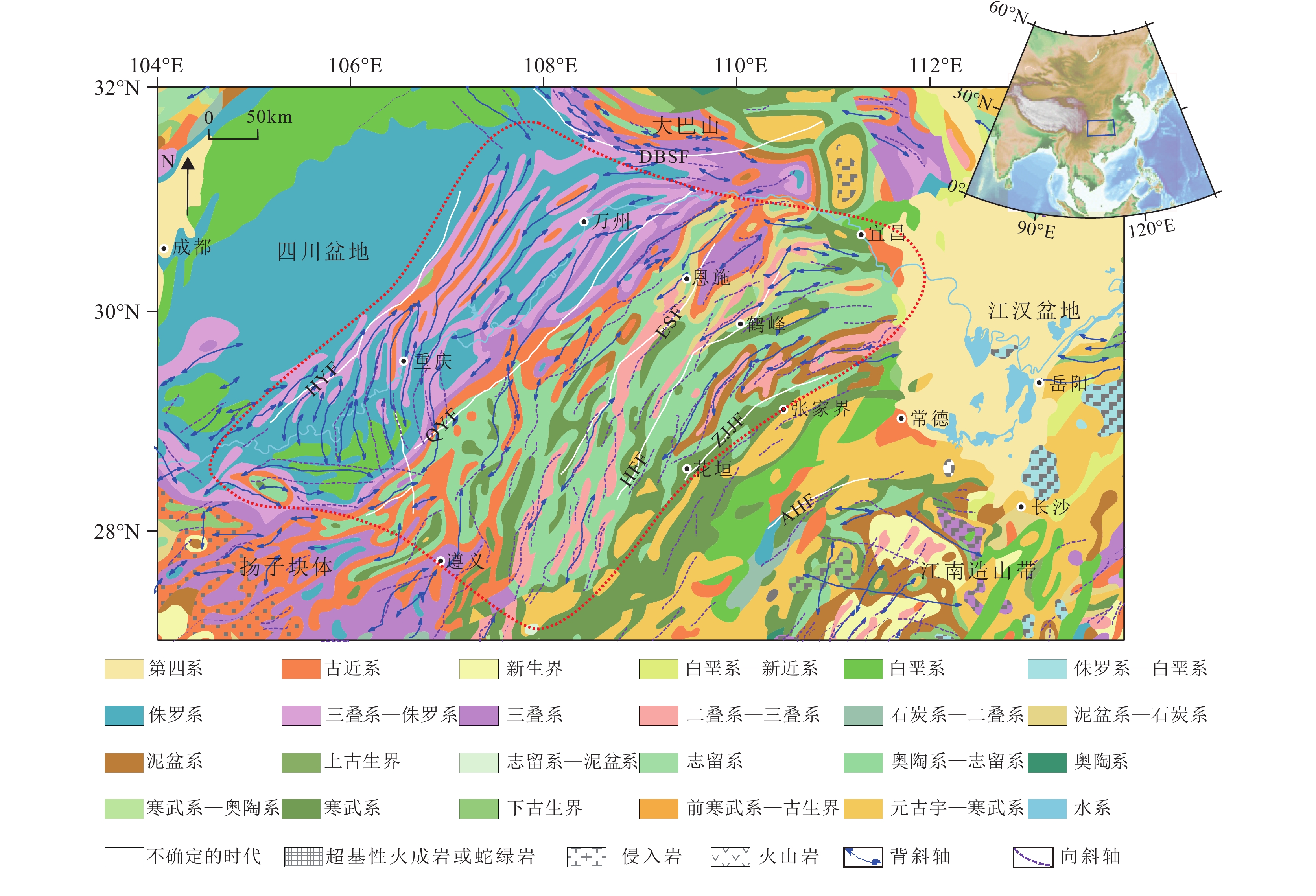
 下载:
下载:
